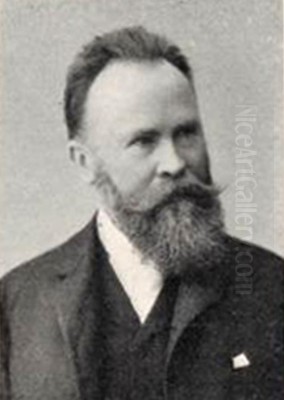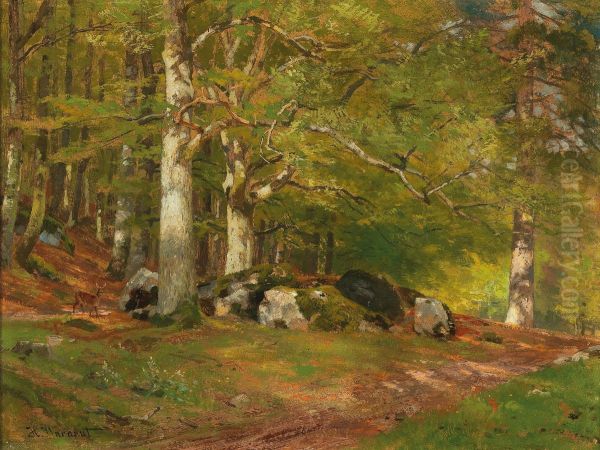Introduction to an Austrian Master

Hugo Darnaut, born Hugo Fix in Dessau in 1850, stands as a significant figure in Austrian art history, particularly renowned for his evocative landscape paintings. Active throughout the late nineteenth and early twentieth centuries until his death in 1937, Darnaut captured the essence of the Austrian countryside with a distinctively lyrical and atmospheric touch. His work is often associated with Austrian Impressionism, specifically the variant known as 'Stimmungsimpressionismus' or Mood Impressionism, which emphasized capturing the emotional ambiance and light of a scene over purely objective representation. He dedicated his career to depicting the natural beauty of his adopted homeland, becoming one of its most respected landscape artists.
Early Life and Artistic Formation
Although born in Dessau, then part of the Duchy of Anhalt in the German Confederation, Darnaut spent his formative years in Graz, Austria. His initial artistic path led him to Vienna, the vibrant cultural heart of the Austro-Hungarian Empire. There, he embarked on formal training, undertaking an apprenticeship with Heinrich Burghart, a painter associated with the prestigious Vienna Court Theatre (Burgtheater). This early exposure likely provided him with a solid foundation in painterly techniques and perhaps theatrical scene painting's sense of atmosphere.
Furthering his education, Darnaut also spent time studying in Düsseldorf. The Düsseldorf School of painting was internationally renowned in the 19th century, particularly for its detailed and often narrative or allegorical landscape and genre scenes. While Darnaut's mature style would lean more towards Impressionism, his time there may have honed his technical skills and appreciation for landscape as a primary subject. This combination of Viennese theatrical artistry and Düsseldorf academic training provided a unique background for his developing artistic voice.
The Essence of Darnaut's Art: Style and Subject Matter

Darnaut's artistic identity is inextricably linked to the Austrian landscape. He drew his primary inspiration from the regions of Upper and Lower Austria, the picturesque Tyrol, and occasionally the Carpathian Mountains. His paintings are celebrated for their idyllic and pastoral quality, often presenting nature as a source of tranquility and harmony. He showed a particular affinity for autumnal scenes, capturing the rich, warm colours and the specific quality of light associated with that season, frequently depicting sunsets casting a golden glow over fields and forests.
His approach went beyond mere topographical accuracy. Darnaut sought to convey the Stimmung – the mood or atmosphere – of the landscapes he observed. His works often explore the subtle interplay of light and shadow, the textures of the natural world, and the quiet relationship between human presence (sometimes implied, sometimes depicted through small figures or rural structures) and the encompassing environment. This focus aligns him with the Austrian tradition of Mood Impressionism, differentiating his work from the more analytical approach of French Impressionists like Claude Monet or Camille Pissarro.
Darnaut was also associated with the Plankenberg artists' colony near Neulengbach in the Vienna Woods. This group, strongly influenced by the pioneering Austrian landscape painter Emil Jakob Schindler (who is often considered Darnaut's most important teacher or mentor figure), focused on capturing the specific atmospheric conditions and scenery of this region through plein air (outdoor) painting techniques. Darnaut's involvement with this circle further cemented his commitment to direct observation and the atmospheric rendering of nature.
Representative Works and Notable Projects
While a comprehensive catalogue raisonné might be extensive, several works and projects highlight Darnaut's career. One frequently mentioned piece is titled A Monk in the Stillness of Stift Millstatt (or similar variations). Although sometimes cited with an anachronistic date of 1819 (likely a transcription error, given Darnaut's birth year), the painting depicts a monk in the cloister of the Millstatt Abbey, surrounded by nature, embodying the themes of tranquility and the spiritual connection to the natural world often found in his work. Another named painting, Willendorf II (1885), likely depicts a scene near the famous Paleolithic site in Lower Austria, showcasing his interest in specific Austrian locales.
Beyond easel paintings, Darnaut engaged in larger-scale projects. He collaborated with the architect Erwin Pendl to create a large panoramic bird's-eye view of Vienna. This impressive work was notably displayed at the Vienna Pavilion during the 1900 Exposition Universelle (World's Fair) in Paris, showcasing the imperial capital to an international audience. Sources also mention a similar, perhaps related, bird's-eye view of Vienna being exhibited in Milan, where Darnaut reportedly received a gold medal for his contribution.
His skills were also employed in architectural decoration. Darnaut was among the artists commissioned to create historical murals for the Vienna Rathauskeller, the cellar restaurant complex beneath the Vienna City Hall. This project, designed by architect Joseph Urban, involved several artists contributing to a decorative scheme celebrating Viennese history and culture, demonstrating Darnaut's versatility beyond pure landscape.
Professional Life, Affiliations, and Recognition
Hugo Darnaut was an active participant in the Viennese art world. He became a member of the prestigious Vienna Künstlerhaus (Society of Austrian Artists), the city's main exhibiting society for traditional artists at the time. His standing within the organization grew significantly, culminating in his election as its President, a position he held from 1913 to 1918. This period covered the tumultuous years of World War I, placing him in a key leadership role within the Austrian art community.
His involvement extended to organizing exhibitions not only in Vienna but also internationally, with shows mentioned in Berlin, Paris, and Venice. This indicates an effort to promote Austrian art abroad and engage with wider European artistic currents. His contributions did not go unnoticed. In 1925, he received the title of Honorary Professor from the Technische Universität Wien (Vienna University of Technology), a significant academic acknowledgment. Furthermore, in 1930, the city of Vienna bestowed upon him the title of Honorary Citizen, recognizing his artistic contributions to the cultural life of the capital.
Darnaut in the Context of Austrian and European Art
Hugo Darnaut operated during a dynamic period in Austrian art. He was a contemporary of other notable Austrian landscape painters associated with Mood Impressionism, such as Olga Wisinger-Florian and Tina Blau, both pioneering female artists who achieved considerable success. His work can be seen as evolving from the earlier, more detailed Biedermeier landscapes of Ferdinand Georg Waldmüller and the precise vedute (city views) of Rudolf von Alt, incorporating the looser brushwork and atmospheric focus championed by his mentor, Emil Jakob Schindler.
While firmly rooted in the Austrian tradition, Darnaut's work existed alongside the burgeoning modernist movements in Vienna, most famously the Vienna Secession founded in 1897 by artists like Gustav Klimt and Carl Moll (who himself started as a landscape painter influenced by Schindler). Darnaut, however, remained largely associated with the more traditional Künstlerhaus. His style, while Impressionistic in its handling of light and atmosphere, generally retained a greater degree of naturalistic detail compared to the more radical experiments of French Impressionism or the subsequent Post-Impressionist explorations of artists like Paul Cézanne.
Compared to German contemporaries like Max Liebermann or Lovis Corinth, who also developed distinct forms of Impressionism, Darnaut's work often maintained a more serene and less overtly dramatic or psychologically charged tone, focusing on the quiet poetry of the Austrian landscape. His dedication to specific Austrian locales and his emphasis on Stimmung define his unique position within the broader European landscape painting tradition of the era.
Legacy and Market Appreciation
Hugo Darnaut remains a highly regarded figure within Austrian art history. His paintings are held in numerous Austrian museums and private collections. His work continues to be appreciated for its technical skill, its sensitive rendering of light and atmosphere, and its evocative portrayal of the Austrian countryside. He successfully captured a specific, often idealized, vision of rural Austria that resonated with audiences of his time and continues to find favour.
His paintings appear regularly on the art market, featuring in auctions both in Austria and internationally. The consistent demand for his work underscores his established reputation and the enduring appeal of his idyllic landscape visions. While perhaps not as internationally famous as the leading French Impressionists or the Vienna Secession stars, Darnaut holds a secure and respected place as a master of Austrian landscape painting.
Conclusion: An Enduring Vision of Austria
Hugo Darnaut dedicated his long artistic career to capturing the soul of the Austrian landscape. Through his mastery of light, colour, and atmosphere, he created works that are both beautiful representations of specific places and evocative expressions of mood and feeling. As a prominent member and leader of the Vienna Künstlerhaus, an influential teacher (indirectly through his association with the Schindler school), and a creator of iconic views like the Vienna panorama, he made significant contributions to the cultural fabric of Austria. His legacy endures in his paintings, which continue to offer a tranquil, harmonious, and deeply felt vision of the natural world, securing his position as a key exponent of Austrian Mood Impressionism and a beloved chronicler of his nation's scenery.